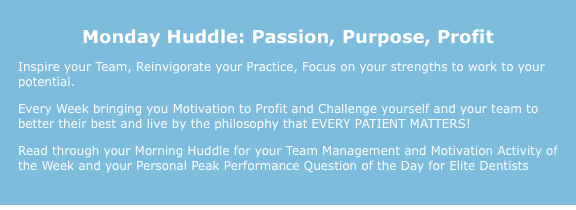Have you made your list yet? You should have.
It really ought to be posted up on the lunch room, all the most common excuses patients give you for not accepting treatment and choosing to get healthy.
We’ve talked about this before. I’ve encouraged it for years. Have you done it and if not, why not? Why wouldn’t you be more proactive with one of the greatest impediments to helping your patients – their excuses.
Here’s the thing, you need daily refreshers, you need to practice and role-play at least monthly, and you have to review results so you have an accurate idea of how well you are doing.
When you think about it, if your response is anything but definitive, confident, directive, and reinforcing the reason why you suggested it in the first place, then you are undervaluing the treatment and undermining their pathway to health.
I have an idea for you: why don’t we stop thinking about treatment as “optional” or as a “recommendation” … “The Doctor recommends such and such,” or “We could do this or that.”
Instead, come from a position authority and sincere concern. The stronger you are when you state the treatment that needs to happen in order to get a desired outcome, the less apt you are to have any pushback whatsoever.
It really is all about the pre-work that builds the value and the necessity of the treatment solution in advance of the ask to accept it.
There are three key points from the previous weeks…
1st – Fix you for you before you worry about fixing you for your patients.
2nd – It is you that needs improvements with more confidence and consistency in what and how you say first, not your patients.
3rd – Building your belief builds your patients’ belief; if you don’t see it as optional then neither will your patients.
Just like everything in life we project onto others. We think “How can I get my patients to say yes to more treatment or to simply value treatment?” It’s the wrong question – it really begins with you. The question should be “How can I become more influential, have more of an impact, and create an experience that compels patients to do what they deserve.”
Do you see the difference in where the emphasis is placed?
Accepting excuses or expressing empathy about…
Money
Time
Health
Age
Insurance
Make your list and check it twice. Understand that these are patient comments – not an objection, not a rejection, not a no – and your goal is to help clarify by giving the patient the information they need in order to reassess and make the best decision for themselves.
Turning patient excuses into patient yeses should become your habitual ability (aside from building the value first and ensuring their clinical buy-in before you ever ask).
No matter whether you are on the phone or in the back or closing the money on the treatment, don’t let your patients’ negativity or excuses get in their way of seeing the value and the impact you can have. It’s okay to do like the old saying goes and don’t take ‘no’ for an answer – because it’s not the right answer as it helps no one. Your job is to help the patient get out of their own way so they can see clearly and move forward on their pathway to health.
Funny, getting the patient out of their own way requires you to get out of theirs first. Remember, it begins with you, not them. And that’s where we’ll pick up next week.



